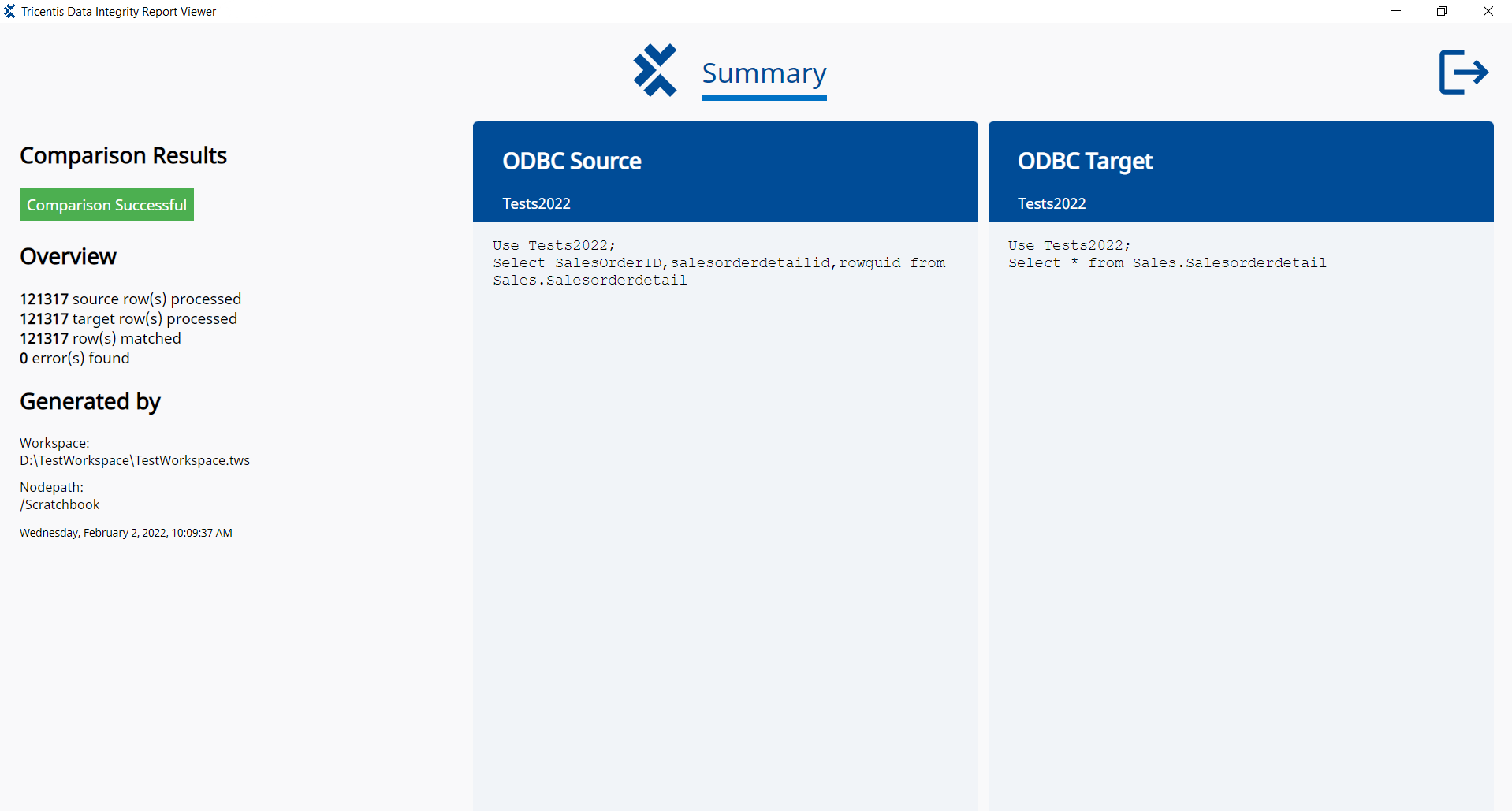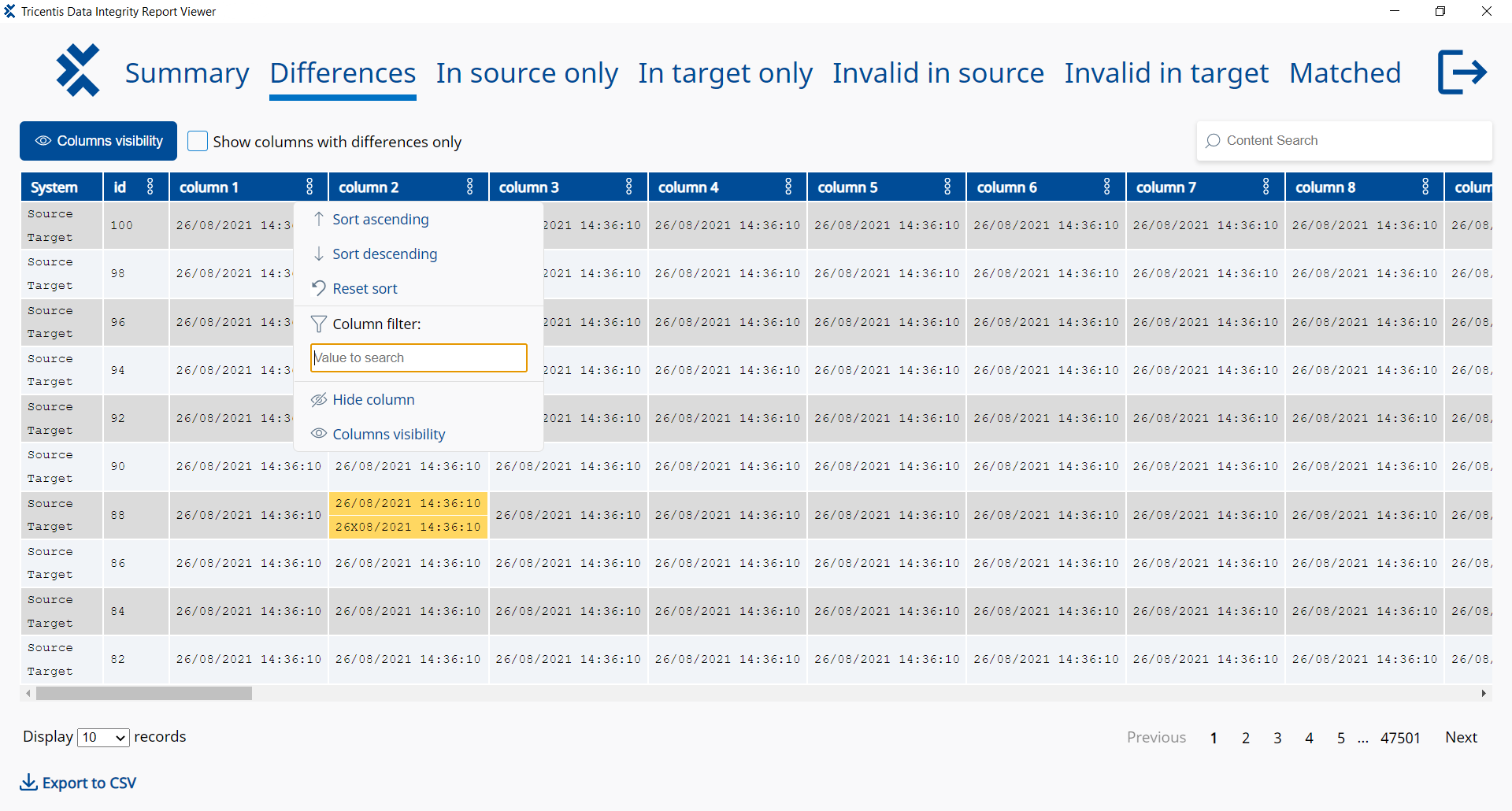Use the Report Viewer
The Data Integrity Report Viewer allows you to open the SQLite database that contains your data directly on your machine and without using a browser. The Report Viewer offers search and filter options that help you find specific data faster. You can also use it to export your report as a CSV file.
If you want to export your report as a CSV file, you have the following options:
-
Export with the Report Viewer, either via the Report Viewer user interface or via command line.
-
Export with the Data Integrity Report Exporter via command line.
The command line options allow you to open and export your reports directly, without any detours across user interfaces.
Open your report
Once you've created your error report, you can open it in the Report Viewer. To do so, follow the steps below:
-
Go to C:\Program Files (x86)\TRICENTIS\Tosca Testsuite\Data Integrity\tools.
-
To open the Report Viewer, run the file Tricentis.DataIntegrity.Report.Viewer.exe.
-
To open a report in the Report Viewer, drag and drop the SQLite file or click Browse to browse for a file on your machine.

Report Viewer displays a report of a successful comparison
Navigate the Report Viewer
The Report Viewer displays the results of your comparison sorted by different criteria. Which tabs you see depends on the comparison results and what you specified in the Complete Row by Row Comparison Module.
To display specific information, click on the tabs at the top of the Report Viewer:
-
Summary is the start page. It displays the comparison results, an overview of the processed data and errors, and a description of the source and target.
-
Differences: get an overview of the compared source and target data.
-
In source only: view errors that are only in the source.
-
In target only: view errors that are only in the target.
-
Invalid in source: see invalid results in the source.
-
Invalid in target: see invalid results in the target.
-
Matched: check matched and unmatched target rows.
Modify your report
To modify and export your report, use the following features of the Report Viewer:
-
Click Columns visibility to select which columns you want to display.
-
Select Shows columns with differences only to display only columns with differences.
-
Enter a search query into the Content Search field to highlight data in the results.
-
Click on the
 Menu icon in the top right corner of each column to sort and filter. You can combine filters on multiple columns to refine your results.
Menu icon in the top right corner of each column to sort and filter. You can combine filters on multiple columns to refine your results. -
Use the Display records field below the data table to specify how many records you want to display per page.
-
Click on Previous, one of the numbers, or Next below the data table to navigate between pages.
-
Click on the
 Exit icon in the upper right corner to go back to the start page, where you can select another report to view.
Exit icon in the upper right corner to go back to the start page, where you can select another report to view.

Report Viewer search, sort, and filter options
Export from the Data Integrity Report Viewer
You can steer the Report Viewer via command line. This allows you to open and export your reports without any detours, you don't have to start the Report Viewer first. Also, you can specify details for the CSV export like the delimiter.
If you export via user interface, the Report Viewer exports the table that you see in the tab, for example Differences. It exports the report with a comma , as delimiter to display the data as it is in the database. You can't specify another delimiter in the Report Viewer. If you use Microsoft Excel and want to format the data differently, refer to the Microsoft Excel documentation.
To do so, follow the steps below:
-
Go to C:\Program Files (x86)\TRICENTIS\Tosca Testsuite\Data Integrity\tools and open a command line.
-
Use the commands as described in the table below:
|
Command |
Description |
|---|---|
|
--open |
Open the Report Viewer. |
|
--file |
Specify the full path to the report file. |
|
--table |
Specify the name of the table that you want to export. Use one of the following possible values: Differences, Matched, Unmatched, Invalid, UnmatchedSource, UnmatchedTarget, InvalidSource, InvalidTarget. |
|
--output |
Specify the full path to the CSV file that you want to write the output to. |
|
--delimiter |
Specify the delimiter that you want to use to separate the values in the CSV file. |
|
--export |
Export the report. |

|
In this example, you want to export a CSV report from the Report Viewer via command line. You use the following command to specify which table to export and where to store it: C:\Program Files (x86)\TRICENTIS\Tosca Testsuite\Data Integrity\tools>Tricentis.DataIntegrity.Report.Viewer.exe export --file C:\Temp\data.sqlite --table UnmatchedTarget --output C:\Temp\report.csv |
Export via user interface
To export via the Report Viewer user interface, follow the steps below:
-
In the Data Integrity Report Viewer, click on the tab that displays the table that you want to export.
-
Click Export to CSV.
-
In the subsequent dialog, select a location and file name for the CSV report.
-
Click Save to create the CSV report.
Export with the Data Integrity Report Exporter
The Data Integrity Report Exporter is a separate tool that allows you to automate exporting and to specify details for the CSV report.
You can steer the Report Exporter via command line. To do so, follow the steps below:
-
On Windows, go to C:\Program Files (x86)\TRICENTIS\Tosca Testsuite\Data Integrity\tools\windows\Tricentis.DataIntegrity.Report.Exporter.exe.
On Linux, go to: C:\Program Files (x86)\TRICENTIS\Tosca Testsuite\Data Integrity\tools\linux\Tricentis.DataIntegrity.Report.Exporter.exe. -
Open a command line.
-
Use the commands as described in the table below:
|
Command |
Description |
Optional |
|---|---|---|
|
--delimiter |
Specify the delimiter that you want to use to separate the values in the CSV file. Data Integrity uses a comma , by default. |
X |
|
--error-no-data |
Specify to exit with the error code ErrorNoTableToExport if no data exists for the specified table. |
X |
|
--help |
Display help information. |
X |
|
--input |
Specify the full path to the report file. |
|
|
--output |
Specify the full path to the CSV file into which you want to write the output. If you don't specify a --table, specify the path to the directory where you want to store the CSV reports for all tables. |
|
|
--progress |
Display the progress of the export. |
X |
|
--table |
Specify the name of the table that you want to export. Use one of the following possible values: Differences, Matched, Unmatched, Invalid, UnmatchedSource, UnmatchedTarget, InvalidSource, InvalidTarget. If you don't specify a table, specify a directory path as --output where you want to store the CSV reports for all tables. |
X |
|
--version |
Display the Report Exporter version. |
X |